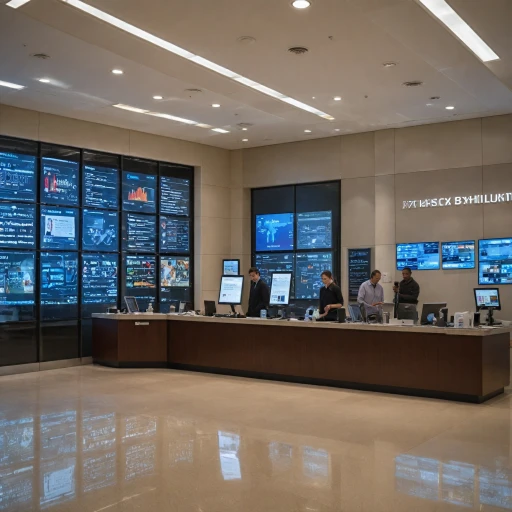The Evolution of Customer Experience as a Business Priority
A Brief History of Customer Experience
Once a peripheral concern, customer experience (CX) now sits as the centerpiece of modern business strategy. In a digital age where product choice is abundant and information is instant, companies that previously leaned solely on the quality of their products have shifted to a more holistic approach. According to PwC, 73% of all people point to customer experience as an important factor in their purchasing decisions. This highlights a crucial trend: companies that excel in delivering top-notch experiences are winning hearts, minds, and wallets.
The Shift Towards a Customer-Centric Model
Apple revolutionized more than just technology; it rewrote the playbook on customer centricity. The brand's loyal following isn't just a result of innovative products but is equally about the joyful experience those products enable. Sensing this shift, giants like Amazon and Google have similarly sculpted their empires with customer experience as a foundation. Fred Reichheld's Net Promoter Score (NPS), which assesses customer satisfaction, has become a fixture in this landscape, showing that successful companies prioritize the feeling customers walk away with.
Understanding the Modern Consumer
Connecting with customers in today's market means understanding their needs on a granular level. Companies that stand out not only provide what customers seek but also respect their time and anticipate needs. Salt Lake City-based Adobe’s findings suggest a personalized experience can dramatically improve business results, with marketers seeing, on average, a 20% increase in sales when tailoring the consumer journey.
The CX Paradigm and Business Performance
It’s clear: investing in great customer experiences isn’t just about feeling good; it’s about solid business outcomes. Gartner reports that more than two-thirds of companies compete primarily on the basis of customer experience. This correlates with findings from Temkin Group, reporting a modest improvement in CX can generate an average revenue increase of $775 million over three years for a $1 billion company.
Exploring consumer behavior strategies and their impacts on market dynamics offers a deeper understanding of this evolution. For strategic insights that drive competitive advantage, one might delve into the nuances of decoding consumer behavior.
Forging Ahead
As we continue peeling back the layers of what makes customer experiences so impactful, the intertwining with personalization, feedback, technology, and the human touch becomes evident. Companies are now mapping, measuring, and improving every step of the customer journey. Seamlessly blending data-driven insights with genuine empathy sets the stage for customer happiness—and business growth.
Decoding the Customer Journey: Mapping Every Touchpoint
Mapping Every Touchpoint
Imagine walking into your favorite store; each step you take, every product you glance at, is a part of your journey with the brand. Now, translate that to every interaction, or touchpoint, a customer has with a company, from browsing online to receiving customer support. It's clear why businesses are keen on understanding and optimizing the customer journey. Companies that meticulously map these touchpoints are more equipped to ensure a positive customer experience.
Experts like Fred Reichheld from Bain & Company, who introduced the Net Promoter Score (NPS), highlight the importance of measuring customer interactions as they have a direct correlation with loyalty and profit. Digital powerhouses such as Apple and Amazon have set benchmarks for seamless customer journeys, resulting in improved customer loyalty and satisfaction.
Moreover, reports by the Temkin Group elucidate that a modest increase in customer experience can significantly boost the revenue of a company. Greater attention to customer journey mapping can facilitate a reduction in customer effort score, an increase in positive customer experience and customer satisfaction scores, which all are indicative of successful customer journey strategies.
Savvy businesses harness customer feedback, leaning on the insights garnered through customer experience software, surveys, and journey mapping tools. They improve customer experience by identifying and addressing bottlenecks and by enhancing the moments of joy.
The art of mapping every touchpoint requires a robust framework that captures not just the direct interactions but also the indirect ones – like social media impressions or word-of-mouth recommendations. Studies show that a comprehensive journey map can unveil the true nature of the customer-brand relationship, sometimes emphasizing areas overlooked by conventional management approaches.
On the forefront of customer-centric approaches, companies are designing preemptive strategies, anticipating needs before they arise. Microsoft's success, for instance, has been partly due to their proactive service, which engages customers before they reach out with issues. This is experience management elevated to strategic heights, and it proves to be an experience customer won't forget.
Wrapping up this segment, create a great customer experience, a deep, introspective look at every journey stage becomes imperative. The use of customer journey maps is not just a trend but a profound aspect of experience strategy. As we progress, remember that data, management, and an intentional service design pave the path for exceptional service that resonates with customers across all touchpoints.
From Data to Delight: Utilizing Customer Feedback to Enhance Service
Unlocking Customer Insights Through Feedback
Understanding customer sentiment is like deciphering a complex code that can unlock the secrets to outstanding service. Today's businesses harness that potential by paying close attention to customer feedback. This isn't about collecting data for the sake of hoarding; it's about lighting the path to improve customer experiences.
Imagine a coffee shop where the barista remembers your name and your order. That's a simple instance of great customer service. But how does a company scale this personal touch? The answer lies in data.
The Journey from Customer Feedback to Enhanced Experiences
Customer satisfaction scores, net promoter scores (NPS), and customer effort scores are more than just numbers. They're voices of people inviting you to refine your service. Brands like Apple and Zappos didn't just stumble upon their legendary status; they listened, learned, and adapted.
Whether it's through carefully crafted surveys or innovative customer experience software, businesses today track every sigh and cheer from their customer base. According to a study by PwC, a whopping 73% of consumers point to experience as an important factor in their purchasing decisions, just behind price and product quality.
A Case Study in Listening: Turning Data into Delight
The transformative tales of customer-centric behemoths like Amazon and Microsoft focus on how deeply they dig into feedback. Each piece of critique and praise is valuable. The sustainable practices that companies adopt aren't just good for the planet—they're good for the customer relationship too, showing that brands listen and care.
Bain & Company, Inc. reports that companies excelling in customer experience grow revenues up to 4-8% above their market. That's no small feat. It takes a steadfast dedication to understanding and implementing what customers are actually saying.
Nuts and Bolts: How Companies Collect and Use Feedback
The process often starts with customer journey mapping, a concept we touched on earlier. It pinpoints the moments that matter most to customers. From there, businesses deploy various methods to gather intel—social media listening, real-time chat feedback, or post-purchase surveys. Advanced technologies, including AI and machine learning from Adobe or Oracle, add depth to the data companies collect, moving them beyond mere service transactions into meaningful interactions.
For example, a report by Gartner highlighted that over 80% of customer service interactions could be handled by AI by 2022. This shift not only streamlines operations but also arms brands with insanely precise data to enhance customer service interactions.
Championing Change Through Feedback
Implementing change based on feedback is like walking a tightrope. It requires balance and precision. Positive customer experiences can turn a one-time purchaser into a lifelong advocate—a truth validated by Fred Reichheld of Bain & Company, the creator of the NPS. As brands pivot based on feedback, they witness a trust transformation. And in the realm of customer service, trust is currency.
A Tempkin Group study suggests that when companies introduce positive experiences, customer loyalty spikes, potentially tripling the likelihood of repeat business. That's the power of using customer feedback to generate positive customer experiences.
Improving customer experience isn't a one-and-done affair; it's an ongoing journey. As brands keep their ears to the ground, listening for the whispers and shouts of customer sentiment, they improve customer service time and again. In this way, they don't just meet expectations but exceed them, turning happy customers into brand evangelists.
The Power of Personalization: Tailoring Experiences for Customer Connection
Unlocking the Identity of Your Clientele
In the bustling marketplace, the spotlight shines on businesses that achieve a personal rapport with their audience. It's not rocket science – customers crave recognition. To harness this, walk in their shoes. Eminent behavioral psychologist, Dr. Susan Weinschenk, insists on the importance of personalization in her book, '100 Things Every Designer Needs to Know About People.' It’s this personal touch that transforms an average service interaction into an anecdote that a customer eagerly shares.
Smart Personalization Engines at Your Service
Digital dynamics allow companies to analyze customer data meticulously. Imagine implementing Smart Personalization Engines (SPEs) that predict what your customers will want next based on previous interactions. Research by Gartner suggests that businesses that have invested in personalization will outperform their competitors in sales by a significant margin. Tech brands like Adobe are spearheading this innovation, harnessing AI and machine learning to offer relevant product suggestions and services tailored to user behavior.
The Art of Asking
Moving beyond the surface, great customer experience dives into the deep end of customer feedback. Customer surveys are not just tick boxes; they're gold mines of actionable insights. Bain & Company's Fred Reichheld, the mastermind behind the Net Promoter Score (NPS), shows us the power of a single question to gauge customer sentiment. It’s not just about receiving feedback, but about responding to it, making customers feel a part of your brand's journey.
Personalized Experience in Real Time
The journey from customer feedback to service refinement is a quick one. The goal? Minimize the time it takes to turn an insight into an action. Case in point: how Amazon’s recommendation system accounts for shopper behavior in real-time, creating a positive feedback loop that enriches customer interactions and boosts satisfaction.
Exceeding Expectations with Unexpected Delights
You don't just meet expectations; you exceed them. This is the mantra of brands like Zappos, renowned for their surprise upgrades and unexpected gifts that turn customers into loyal fans. These moments, while seemingly small, can have an outsized impact on the overall perception of a brand, reinforcing the positive customer experience.
Enculturation of Customer-Centricity
A personalized approach isn't a one-and-done campaign; it's a culture. Companies that thrive embed this philosophy into their ethos. Apple’s genius lies not just in its products but in its consistent, personalized customer support across all touchpoints. This kind of brand commitment requires a concerted effort from every employee, fostering a customer-centric culture that differentiates a company from its competitors.
Key Takeaways for Experience Maestros
Effective personalization isn’t accidental – it's a result of strategic planning and implementation. Customer experience champions mix the art of empathy with the science of data. They recognize patterns, strategies, and signals that map out a blueprint for individual engagements. Satisfaction scores become the north star, guiding businesses on a never-ending quest to cement their brand in the hearts and minds of their customers.
Innovating with Intent: The Role of Technology in Shaping Customer Experiences
Embracing Tech to Enhance Customer Interactions
Interactive technology has redefined the traditional customer service model, leading businesses to innovate at every opportunity. For instance, companies like Amazon and Microsoft provide a blueprint for integrating technology seamlessly into the customer journey. Amazon's use of AI for product recommendations and Microsoft's focus on improving customer support with chatbots are just a couple of the innovative strategies that have set new standards for customer technology interfaces.
Leveraging Big Data for a Personal Touch
Data analytics is no longer just a buzzword — it's a crucial asset for understanding and improving customer experience. Utilizing tools to analyze customer feedback and behavior patterns helps businesses tailor their services to what clients truly desire. Industry experts from PwC and Gartner have shown that leveraging big data can result in a positive customer experience that fosters loyalty and enhances brand reputation.
Real-Time Solutions with IoT and Wearables
The Internet of Things (IoT) and wearable technology provide instant, contextual service that elevates customer satisfaction. For example, fitness brands leveraging wearables can offer personalized health insights, creating a proactive service ecosystem. This illustrates how real-time data improves customer interactions, a strategy confirmed by reports from Bain & Company, highlighting the impact of immediate, personalized responses on customer sentiment.
Incorporating AR/VR for an Immersive Experience
Technology giants like Apple and Google are pioneering immersive customer experiences through AR and VR. These technologies not only captivate customers but also deliver interactive and informative product demonstrations, enriching the purchase journey and creating memorable brand interactions.
Integrating Customer Experience Software
Software solutions dedicated to customer experience, such as CRM platforms from Salesforce and Oracle, enable companies to manage and analyze customer interactions across every touchpoint. As a result, businesses can deliver a consistent and satisfying journey, from initial contact to post-service support.
Bridge to Tomorrow: AI and the Evolution of Customer Service
AI is the golden thread weaving through the narrative of next-gen customer service. Its predictive capabilities empower companies like Adobe and Oracle to anticipate customer needs and solve issues before they escalate, creating a proactive and dynamic service atmosphere. Studies by Fred Reichheld and the Temkin Group have underlined the importance of this anticipatory approach in sustaining great customer experiences.
Streamlining Experience Through Automation and Machine Learning
Automation and machine learning are not merely about efficiency; they're about curating an experience that feels effortless and intuitive. The streamlined processes they facilitate can significantly reduce the customer effort score, a metric vital for customer retention. Examples from industry leaders like Zappos and Apple showcase how such technologies can automate mundane tasks, freeing up human agents to handle more complex, value-adding interactions that underpin a great customer experience.
The Human Touch: Balancing Digital and Human Elements in Service
Where Digital Meets Human: Crafting Seamless Interactions
In an age where chatbots and automated services are ever-present, the craving for human connection within the digital sphere has intensified. Companies today recognize that while the digitalization of customer service generates efficiency, it's the human touch that often solidifies customer loyalty and brand connection. Statistics show startling figures with a report by PwC revealing that 82% of U.S. and 74% of non-U.S. consumers want more human interaction in the future.
Bringing human elements into the customer journey is more than just a conversation; it's about creating an emotional bond with customers. Bain & Company, Inc. further adds weight to this by stating that companies that excel in the customer experience grow revenues 4-8% above their market.
Expert Insights on Integrating Human-Centric Service
According to experts like Fred Reichheld from Bain & Company, the creator of the Net Promoter Score (NPS), the key to a great customer experience is not just about solving issues but delighting customers. His book, 'The Ultimate Question 2.0', delves deep into how genuine customer-centric cultures thrive. Apple and Zappos are prime examples where positive customer experiences have been deeply embedded into their customer service DNA.
Surveys from Adobe and Econsultancy show that companies emphasizing customer experience are three times more likely to exceed their business goals. In customer experiences, the devil is in the details. Microsoft's studies suggest a reduction in human interaction leads to a decrease in customer satisfaction scores.
Case Studies: Humanizing Customer Interactions
Amazon's mayday button is a noted case study where customer support is enhanced with a human touch. On the flip side, the Temkin Group's research indicates that a bad digital experience can severely damage a brand's reputation with a single poor customer service encounter leading to a 65% of customers severing ties with the brand.
However, it is important to not just add human elements for the sake of it. They need to be meaningful and improve customer experience. A study by Gartner highlighted that more than 80% of customer service interactions could be improved with better integration of digital and human elements.
Bringing Empathy to the Forefront of Digital Experiences
The emphasis on empathy in customer experiences can't be overstated. A study by the Journal of Consumer Research found that customers could sense the empathy in a service interaction, and it led to higher customer satisfaction scores. Integrating empathic design into digital tools, like customer journey mapping software, can help companies improve customer journey comprehensively.
To create that positive customer experience, firms are also turning to customer experience management (CEM) systems. Systems like Oracle's CEM and Adobe's Experience Manager help businesses manage and deliver personalized experiences at scale.
Tackling the Challenge of Blending Digital with the Human Element
A delicate balance is required. Consider the role of customer effort score (CES), which measures the ease of customer interaction and the resolution of their issues. Improving customer experience requires lowering the effort customers need to exert. It's crucial to address not only the digital but the emotional hurdles customers face. Salt Lake City's XM Institute has found that a focus on reducing customer effort can increase loyalty.
Ultimately, the most successful businesses in the customer experience frontier are anchoring their strategies in the human experience. They treat each customer journey as a holistic human encounter and not just a transaction. By doing this, they are reshaping the landscape of customer experience and setting benchmarks for others to follow.
Measuring Success: The Metrics Behind Great Customer Experiences
Grasping the Gauge: How Effective is Your Customer Service?
Lifting the customer experience from good to great hinges on the clarity and precision of the feedback loop. The numbers speak loud and clear, with 86% of buyers willing to pay more for a great customer experience, according to a PwC report. How do companies know if they're delivering on the promise of great experiences? That's where effective measurement tools come into play.
Universal Yardsticks: Net Promoter Score and Friends
The Net Promoter Score (NPS) has become a gold standard, enabling businesses to distill customer sentiments into a single actionable figure. Bain & Company, the creator of NPS, highlights it to be linked with revenue growth. But NPS isn't alone. Companies use a suite of metrics such as Customer Satisfaction Score (CSAT) and Customer Effort Score (CES) to triangulate consumer contentment. These metrics, signaling the health of customer relations, are critical in tailoring a customer-centric strategy.
Capturing the Customer Pulse: Surveys, Social Listening, and Beyond
Surveys have long been a staple for capturing customer perspectives, with feedback mechanisms evolving digitally. Brands like Microsoft and Oracle lead by leveraging customer experience software to gather real-time insights. However, the conversation doesn't end there. Adobe’s studies reveal a high 89% of companies rely on social listening for understanding and improving customer experience. This practice enables brands to catch the customer's voice where it's most organic, providing an unfiltered view of the experience pulse.
Peer Under the Digital Hood: Analytics and Experience Management
Digital footprints left by customers throughout their online journey create a dense data trail. This treasure trove fuels advanced analytics, helping companies like Amazon and Apple micro-segment and elevate customer journeys with precision. To discern patterns and predict trends, businesses are also incorporating experience management platforms, or XM, which Gartner identifies as crucial for assessing and improving experiences with holistic data insights.
The Evolving Panorama: Customer Experience Management
Customer Experience Management (CXM) is not static; it adapts as the dialogue between customers and brands evolves. What was once a unidirectional plea for customer feedback has morphed into an ongoing conversation. According to Satmetrix Systems, Inc., companies with strong CXM grow revenue as much as eight times faster than those without. This vividly indicates businesses need to integrate feedback into a continuous improvement loop, upholding and enhancing experiences over time.
Case in Point: Leading by Example
Evidence from the trenches can inspire confidence for others. Zappos, a beacon of great customer service, utilizes a mixture of quantifiable data points and anecdotal evidence to maintain its celebrated culture. They know when satisfaction is high, advocacy follows; as found in a study by Temkin Group, where customers with great experiences are 3.5 times more likely to make additional purchases than those with poor experiences.
Conclusion: Metrics Map the Pathway to Greatness
To close, the complexities of measuring customer experience may seem daunting, yet, the essential truth remains: what gets measured, gets managed. Advanced customer experience strategies are inseparable from their metrics – they are the compass by which a brand navigates the vast and dynamic ocean of consumer needs. As companies strive to weave compelling experiences into the fabric of their value proposition, their journey is illuminated by the data that captures the heart of all business endeavors – the customer experience.
Future Trends in Customer Experience Strategy
The Intersection of AI and Humanity
As customers crave more personalized experiences, companies lean into artificial intelligence (AI) and machine learning. These technologies crunch data to predict preferences and offer recommendations. A recent Gartner report revealed that organizations using customer journey mapping tools interspersed with AI capabilities witnessed a 25% uplift in customer satisfaction. We're observing companies like Amazon using AI to tailor user experiences, leading to repeat business and increased loyalty.
The Rise of Experience Ecosystems
More businesses realize that customer experience doesn't exist in a vacuum. It’s an ecosystem involving every interaction, both digital and physical. Bain & Company, known for its endorsement of Net Promoter Score (NPS), suggests that companies with superior customer experience grow revenues 4-8% above their market. So it’s no surprise we're seeing a surge in cross-channel experience management, aimed at delivering consistent and interconnected experiences that add to the customer lifecycle value.
Embracing the Feedback Loop
Feedback is the cornerstone of improvement. A PwC survey indicates that 73% of people point to experience as a key factor in their purchasing decisions. Companies harnessing real-time feedback are achieving greater success in adapting and enhancing their service offerings. Moving beyond the traditional surveys, brands are cultivating deep insights by integrating feedback into every customer touchpoint, drawing a clear line between listening and actionable outcomes.
Experiential Loyalty Takes Center Stage
The Fred Reichheld-created Net Promoter System is evolving, as brands shift focus from transactional loyalty to experiential loyalty. The future is not only about how often customers shop but how they feel about the brand. A study by Temkin Group emphasizes that emotion is the most significant driver of loyalty in many industries. In line with this, businesses are crafting experiences that resonate on an emotional level, encouraging positive memories and connections.
Customer Centricity as a Cultural Pillar
Salt Lake City’s XM institute found that companies with a customer-centric culture report higher employee engagement and customer retention rates. This isn’t merely about giving lip service to customer needs; it involves the entire company—from C-suite to frontline workers—prioritizing the customer at every decision point. It is becoming increasingly clear that customer-centric cultures are not just better for consumer satisfaction—they positively impact the bottom line.














